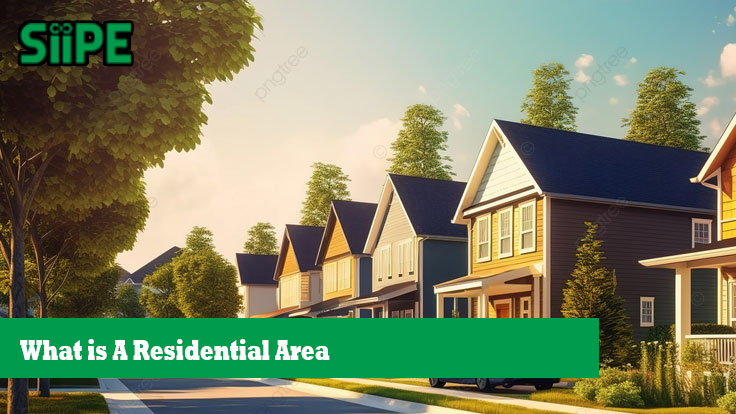A residential area is a geographic region that is primarily composed of housing and is designed for people to live in. These areas are vital components of cities and towns, offering spaces for homes, community interaction, and everyday living. Residential areas vary greatly in terms of size, density, and the types of homes they contain, ranging from urban apartments to suburban neighborhoods and rural villages.
Characteristics of Residential Areas
Residential areas are characterized by several distinct features that differentiate them from commercial or industrial zones:
Housing Types
Residential areas can include a variety of housing types, such as single-family homes, townhouses, apartments, and condominiums. The design and architecture of these homes can vary widely based on cultural, economic, and geographic factors.
Community Facilities
These areas often include facilities that support the community, such as schools, parks, playgrounds, community centers, and religious institutions. These facilities are crucial for fostering community engagement and providing essential services to residents.
Infrastructure
Residential areas are typically equipped with infrastructure such as roads, sidewalks, public transportation, and utilities (water, electricity, sewage, and waste management). Good infrastructure ensures that residents have easy access to necessary services and can move around the area efficiently.
Green Spaces
Many residential areas include green spaces like gardens, parks, and recreational areas. These spaces provide aesthetic value, recreational opportunities, and environmental benefits, such as reducing urban heat and improving air quality.
Types of Residential Areas
Residential areas can be classified into different types based on their density, location, and the nature of the housing provided. Some common types include:
Urban Residential Areas
These areas are located within cities and are often densely populated. They typically consist of high-rise apartments, condominiums, and closely spaced townhouses. Urban residential areas offer easy access to city amenities like shops, restaurants, and public transportation.
Suburban Residential Areas
Found on the outskirts of cities, suburban areas are less densely populated than urban areas. They usually feature single-family homes with yards, wider streets, and more green spaces. Suburbs are designed to provide a balance between city convenience and the tranquility of a more rural setting.
Rural Residential Areas
These are located in the countryside and are characterized by low population density. Housing in rural areas often consists of larger homes on larger plots of land, sometimes including farms or ranches. Rural residential areas offer a peaceful living environment with close proximity to nature.
Mixed-Use Residential Areas
Some areas combine residential properties with commercial and industrial spaces. This type of zoning supports a live-work-play environment where residents can access shops, offices, and recreational facilities within walking distance of their homes.
Planning and Zoning of Residential Areas
The development of residential areas involves careful planning and zoning to ensure that they meet the needs of the community and provide a safe and pleasant living environment. Urban planners and local governments play a key role in this process, considering factors such as:
Land Use
Determining how land is used within residential areas is crucial. Planners need to allocate space for housing, schools, parks, and other community facilities while maintaining a balance between developed and undeveloped land.
Density
Deciding on the density of housing is important for managing population growth and providing necessary services. High-density areas can accommodate more people but require robust infrastructure, while low-density areas offer more space but may need more extensive transportation networks.
Transportation
Effective transportation planning ensures that residents can easily commute to work, school, and other activities. This includes the provision of roads, public transit, bike lanes, and pedestrian pathways.
Environmental Considerations
Sustainable planning practices are essential for minimizing environmental impact. This includes preserving green spaces, implementing energy-efficient building codes, and managing waste and water resources effectively.
The Importance of Residential Areas
Residential areas are fundamental to the social and economic fabric of any region. They provide a place for people to live, work, and play, and contribute to the overall quality of life. Key aspects of their importance include:
Housing
Providing adequate and affordable housing is one of the primary functions of residential areas. A diverse range of housing options ensures that different needs and preferences are met, from affordable housing for low-income families to luxury homes.
Community
Residential areas foster a sense of community by providing spaces where people can interact, form relationships, and support each other. Community facilities and events help build social cohesion and a sense of belonging.
Economic Impact
The development and maintenance of residential areas create jobs and stimulate economic activity. Construction, real estate, and local businesses all benefit from thriving residential communities.
Public Health
Well-designed residential areas can promote public health by providing access to green spaces, recreational facilities, and safe environments. Walkable neighborhoods and access to fresh food markets contribute to healthier lifestyles.
Challenges Facing Residential Areas
While residential areas are essential, they also face several challenges that need to be addressed to ensure their sustainability and livability:
Urban Sprawl
The expansion of cities into suburban and rural areas can lead to urban sprawl, which strains infrastructure, increases traffic congestion, and reduces green spaces. Smart growth strategies are needed to manage development and preserve the environment.
Housing Affordability
The rising cost of housing in many areas makes it difficult for low- and middle-income families to find affordable homes. Policies that promote affordable housing development and provide financial assistance to those in need are crucial.
Infrastructure Aging
Many residential areas have aging infrastructure that requires maintenance and upgrades. Investing in modern infrastructure ensures that communities remain safe and functional.
Environmental Sustainability
Residential areas must adopt sustainable practices to reduce their environmental footprint. This includes energy-efficient buildings, renewable energy sources, and sustainable waste management systems.
More Than Just a Place to Live
Residential areas are more than just places to live; they are vibrant communities that contribute to the social, economic, and environmental well-being of a region. As urbanization continues and populations grow, the planning and development of residential areas will play a crucial role in shaping the future of our cities and towns. By addressing the challenges and leveraging opportunities, we can create residential areas that are sustainable, inclusive, and conducive to a high quality of life











